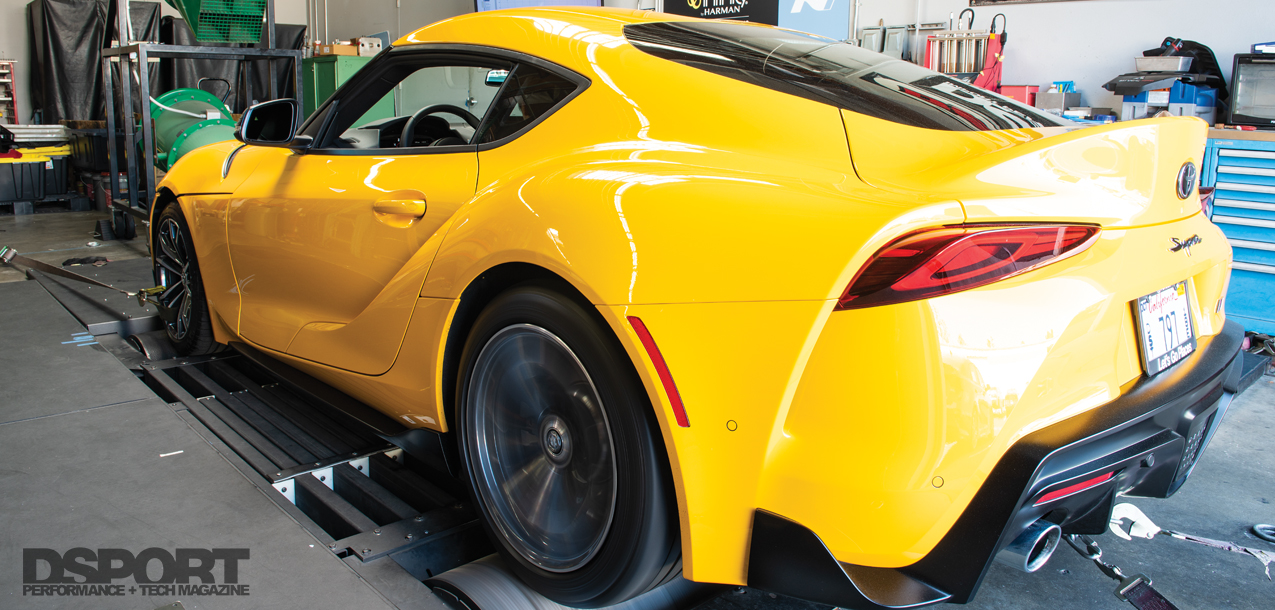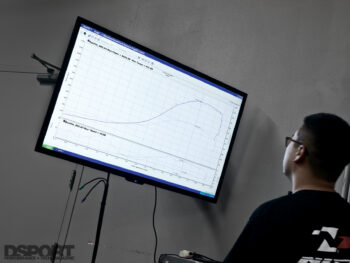DSPORT Issue #247
Text by Michael Ferrara
That’s not good…your dyno has an STd. unless you run a dyno for a living, you may not get this joke so let us explain. All dynos have some sort of correction factor available while some may offer a selection of different correction factors. The purpose of using “corrected” dyno data is that it allows the power output under different temperature, barometric pressure and humidity conditions to be compared. The power output of the same engine might be 5.0 percent lower on a hot, humid and rainy day versus a cool, dry and sunny day. As a result, uncorrected dyno numbers have little value except for knowing exactly how much power is delivered under those exact conditions encountered during the testing. Using corrected horsepower allows comparisons when tests are done under different conditions. Ideally, dyno testing of products should be conducted under like conditions when possible to provide consistent results. Even under like conditions, a correction factor should be used to minimize the impact of weather conditions. With a good understanding of correction factors, you’ll not only understand the opening joke, but you’ll also know when someone may be trying to artificially inflate their engine’s performance level.
Dyno to Dyno Variance
There are some chassis dynos that allow the user to input a calibration constant that will allow the dyno to read higher or lower. Other dynos have fixed parameters set (such as DynoJet dynos). In the case of dynos with fixed parameters, one can expect to see nearly identical power outputs from the same vehicle on different dynos. This is one reason why DynoJet dynos gained a great deal of market share initially and why we’ve always relied upon the data as it can be easily replicated on other DynoJet dynos. With an SAE correction factor applied and a like model DynoJet being used, results from
the same car at different dyno locations are usually within 1-percent. On other dynos that allow operator manipulation of a calibration constant, you can see variances of 25 percent or more even when the make and model of the dyno is the same.
Real Results
If you really want to give validity to a dyno graph, make sure that a stock vehicle’s engine output is also included and calculate the percent improvement to qualify the claim. When a dyno claims a 500whp output for its turbo kit upgrade but doesn’t show exactly what the stock engine does on the same dyno, there is no reference provided. For example, a 500 horsepower dyno on an engine that originally made 250 horsepower is a 100-percent increase. However, if the stock engine on a dyno shows 335 horsepower with a turbo kit horsepower of 500 horsepower, the turbo kit only provides a 50-percent increase in power. Having a reference is key to qualifying horsepower claims even when a dyno is provided.
Brake Horsepower vs Wheel Horsepower
BHP or brake horsepower is the measure of horsepower at the flywheel of the engine when the engine is not installed in the vehicle. WHP or wheel horsepower is the measure of the horsepower being delivered to the wheels on a chassis dyno. In comparing the two, the majority of vehicles will show a loss of about 15-percent between the flywheel rated OEM numbers and the actually recorded power figures on the chassis dyno. For years, Dynojet dynos would always show this exact correlation on nearly every OEM vehicle. However, OEMs decided to under rate the power output of the engine more recently. In many cases this is done to elevate the benefit of getting the higher end version of the vehicle. For many years, the actual power difference between the WRX and STi was measurably smaller than the advertised difference.

The standardized conversion for BHP to WHP or WHP to BHP is as follows.
To convert WHP to BHP, divide by 0.85.
To convert BHP to WHP, multiply by 0.85
A 425whp vehicle will convert to 500BHP (425/0.85). A 500BHP vehicle will covert to 425WHP using this conversion. As far as using a different conversion factor for FWD, RWD or AWD, don’t bother. There isn’t as much of a difference as you may have been led to believe as AWD vehicles are rarely in a locked mode where all four where are locked and powered.

The Bottom Line
There are two primary ways that disinformation is spread. First, some people know they are lying or misleading and they use misdirection or confusion to spread the lie. Second, many people are a bit more ignorant than they give themselves credit for being. In these cases, people may even have good intentions when they tell them complete lies. Whatever the case may be, increasing your own level of knowledge and intelligence will help you identify the lies. Search engines and influencers may not have the algorithms, intelligence or interest in giving you the truth. Get smart and stay tuned by continuing to read and support DSPORT.




